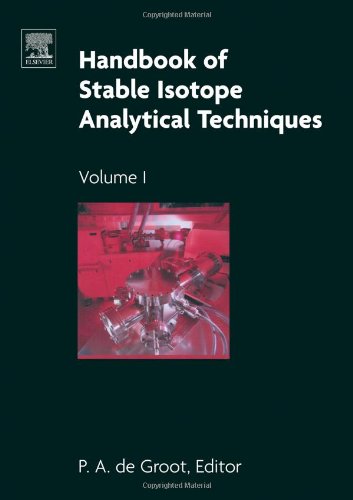

Most ebook files are in PDF format, so you can easily read them using various software such as Foxit Reader or directly on the Google Chrome browser.
Some ebook files are released by publishers in other formats such as .awz, .mobi, .epub, .fb2, etc. You may need to install specific software to read these formats on mobile/PC, such as Calibre.
Please read the tutorial at this link: https://ebookbell.com/faq
We offer FREE conversion to the popular formats you request; however, this may take some time. Therefore, right after payment, please email us, and we will try to provide the service as quickly as possible.
For some exceptional file formats or broken links (if any), please refrain from opening any disputes. Instead, email us first, and we will try to assist within a maximum of 6 hours.
EbookBell Team

5.0
78 reviews
ISBN 13: 9780444511140
Author: Pier A de Groot
(Parent with price) Volume I contains subjective reviews, specialized and novel technique descriptions by guest authors. Part 1 includes contributions on purely analytical techniques and Part 2 includes matters such as development of mass spectrometers, stability of ion sources, standards and calibration, correction procedures and experimental methods to obtain isotopic fractionation factors.
Part 1: Review and Discussion on Developments in Stable Isotope Analytical Technologies
Chapter 1. Stable Isotope Analysis of Water and Aqueous Solutions by Conventional Dual-Inlet Mass Sp
Chapter 2. Conventional and Less Conventional Techniques for Hydrogen and Oxygen Isotope Analysis of
Chapter 3. Techniques for Stable Isotope Analysis of Fluid and Gaseous Inclusions
Chapter 4. Selected Ion Flow Tube Mass Spectrometry (SIFT-MS) and Flowing Afterglow Mass Spectrometr
Chapter 5. Natural Abundance 2H-NMR Spectroscopy. Application to Food Analysis
Chapter 6. Mass Spectrometric Techniques for the Determination of Lithium Isotopic Composition in Ge
Chapter 7. Thermal Ionization Mass Spectrometry Techniques for Boron Isotopic Analysis: A Review
Chapter 8. GC and IRMS Technology for 13C and 15N Analysis on Organic Compounds and Related Gases
Chapter 9. Preparation of Ecological and Biochemical Samples for Isotope Analysis
Chapter 10. Extraction of Dissolved Inorganic Carbon (DIC) in Natural Waters for Isotopic Analyses
Chapter 11. Compound Specific Isotope Analysis of the Organic Constituents in the Murchison Meteorit
Chapter 12. A New Method for the Isotopic Examination of Sub-Milligram Carbonate Samples, Using Sulp
Chapter 13. Determination of the Abundance and Stable Isotopic Composition of Trace Quantities of C
Chapter 14. Stable isotope measurements of atmospheric CO2 and CH4
Chapter 15. Preparation and Analysis of Nitrogen-bearing Compounds in Water for Stable Isotope Ratio
Chapter 16. δ15N Analyses of Ammonium-Rich Silicate Minerals by Sealed-Tube Extractions and Dual In
Chapter 17. Nitrogen Isotopic Analyses at the Sub-Picomole Level Using an Ultra-low Blank Laser Extr
Chapter 18. Mass Independently Fractionated Ozone in the Earth's Atmosphere and in the Laboratory
Chapter 19. Site-specific Nitrogen Isotope Analysis in N2O by Mass Spectrometry
Chapter 20. Fluorination Methods in Stable Isotope Analysis
Chapter 21. Oxygen Isotope Analysis of Plant Water Without Extraction Procedure
Chapter 22. Oxygen Isotope Analysis of Phosphate
Chapter 23. Pyrolysis Techniques for Oxygen Isotope Analysis of Cellulose
Chapter 24. Sample Homogeneity and Cellulose Extraction from Plant Tissue for Stable Isotope Analyse
Chapter 25. Analytical Methods for Silicon Isotope Determinations
Chapter 26. Procedures for Sulfur Isotope Abundance Studies
Chapter 27. Direct Measurement of the Content and Isotopic Composition of Sulfur in Black Shales by
Chapter 28. Summary of Methods for Determining the Stable Isotope Composition of Chlorine and Bromin
Chapter 29. Selenium, Iron and Chromium Stable Isotope Ratio Measurements by the Double Isotope Spik
Chapter 30. SIMS Measurement of Stable Isotopes
Chapter 31. Stable Isotope Analysis by Multiple Collector ICP-MS
Chapter 32. Different Isotope Ratio Measurement Applications for Different Types of ICP-MS: Comparat
Chapter 33. Isotope Ratio Analysis Techniques using Photoionization as a Source of Ions
Chapter 34. Isotope Ratio Infrared Spectrometry
Chapter 35. Glow Discharge Mass Spectrometry: Fundamentals and Potential Applications in Stable Isot
Chapter 36. The Use of Molecular Sieves in Stable Isotope Analysis
Chapter 37. Introduction to Isotope Dilution Mass Spectrometry (IDMS)
Part 2: Calibration and Correction Procedures, Standards, Mass Spectrometers, Experimental Isotope F
Chapter 38. Mass Spectrometer Hardware for Analyzing Stable Isotope Ratios
Chapter 39. Techniques of Ion Current Stabilization in Isotope Ratio Mass Spectrometry
Chapter 40. International Stable Isotope Reference Materials
Chapter 41. The Nature and Role of Primary Certified Isotopic Reference Materials: A Tool to Underpi
Chapter 42. Traceability in Isotopic Measurements
Chapter 43. Strategies and Practicalities in the Production and Use of Gas Isotope Standard Material
Chapter 44. Data Corrections for Mass-Spectrometer Analysis of SO2
Chapter 45. Oxygen Isotope Corrections in Continuous-Flow Measurements of SO2
Chapter 46. Experimental Measurement of Isotopic Fractionation Factors and Rates and Mechanisms of R
Chapter 47. Laboratory Set-Up for GC-MS and Continuous-Flow IRMS
stable isotope forensics pdf
what is stable isotope analysis used for
how does stable isotope analysis work
handbook of radioactivity analysis pdf free download
handbook of stability testing in pharmaceutical development
isotope analysis techniques
stable isotopes analysis
Tags: Pier A de Groot, Stable, Isotope